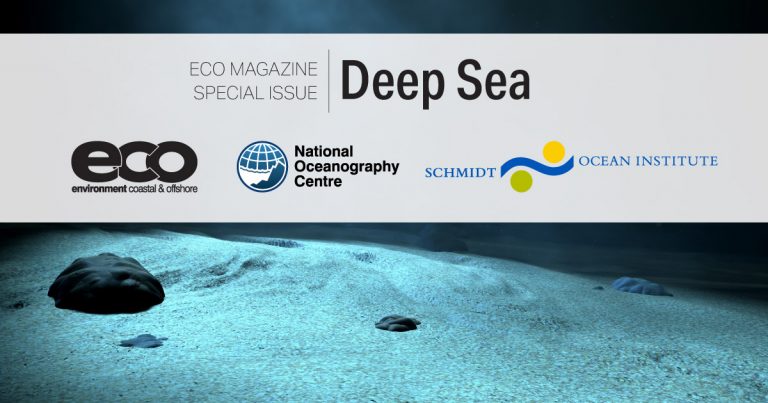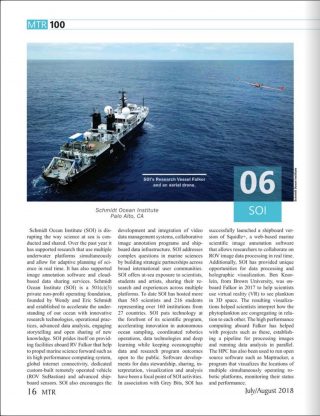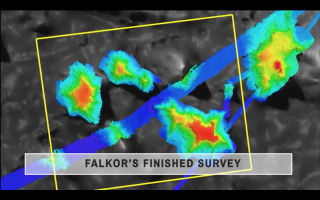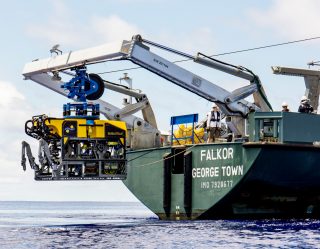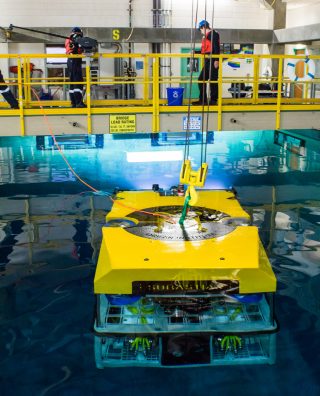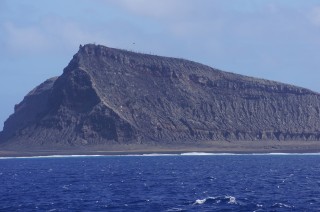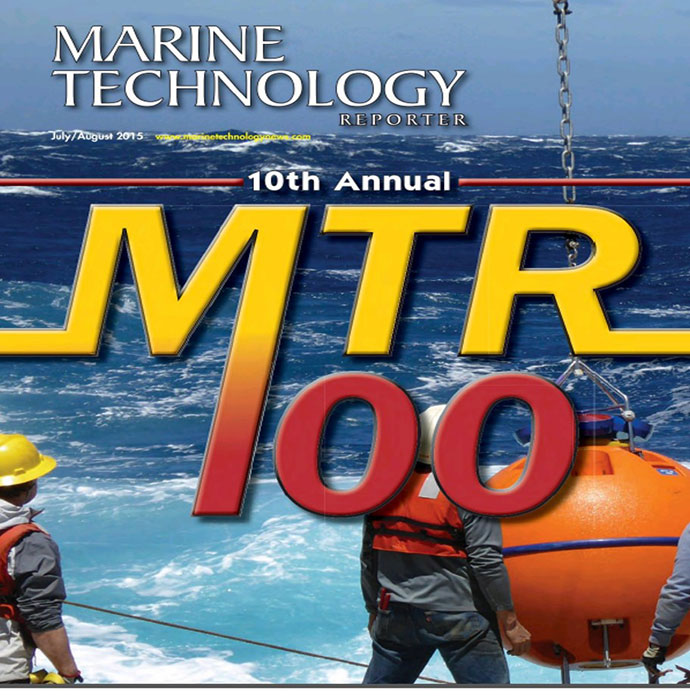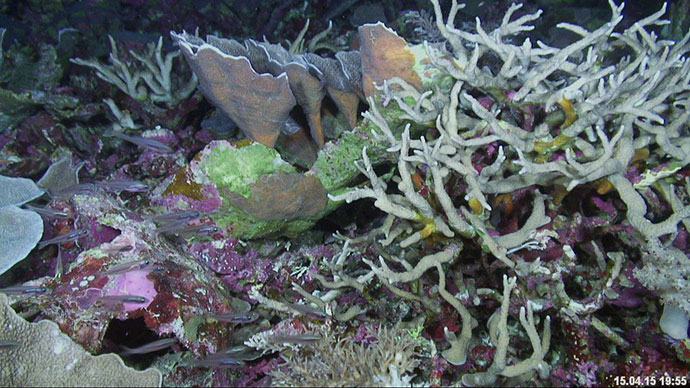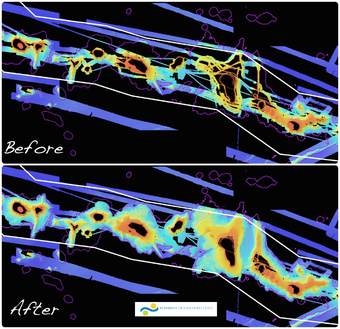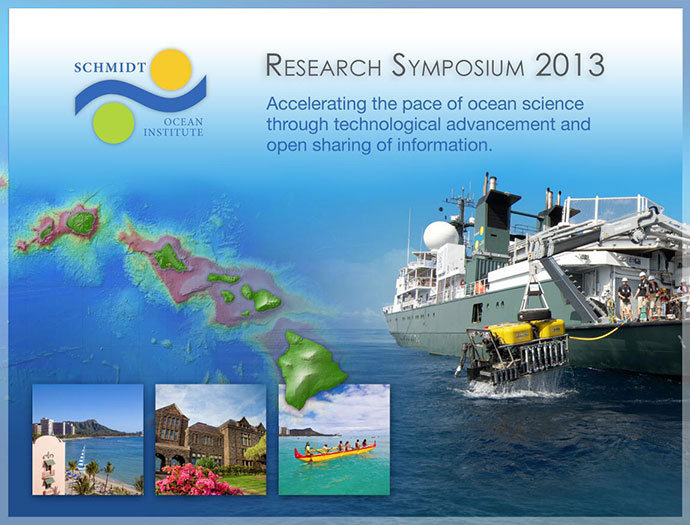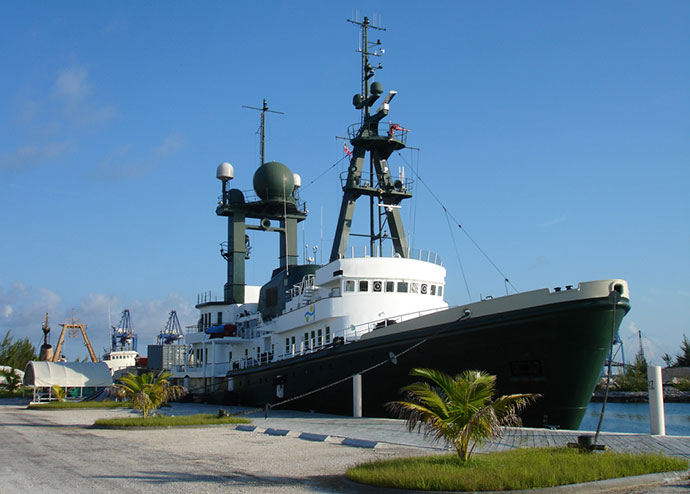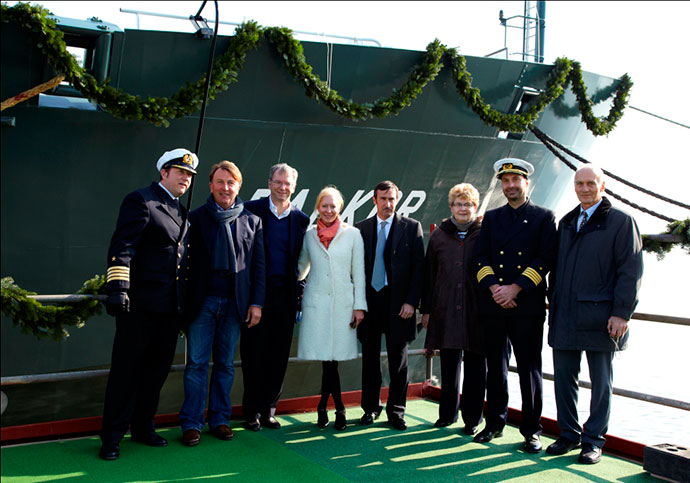Schmidt Ocean Institue Acquires New Research Vessel To Expand Ability To Explore, Research The Ocean
March 23, 2021
Schmidt Ocean Institute announced today it has acquired a new research vessel that will expand the organization’s philanthropic science program and capability to explore the Ocean.
The new ship is significantly larger and can travel further than Schmidt Ocean Institute’s existing research vessel, Falkor, which has been operating since 2012 and was the world’s first year-round philanthropic research vessel made available for free to scientists. The new vessel was purchased from GC Rieber Shipping ASA as the Polar Queen and was built in 2011 as an offshore industry vessel, used most recently to construct offshore wind farms in Europe. The new ship –re-named Falkor (too)— is 363 feet in length, compared to the 272-foot Falkor, built in 1980. The new vessel is also ice-rated and can cover more of the globe, extending Schmidt Ocean Institute’s reach. More in the Press Release.
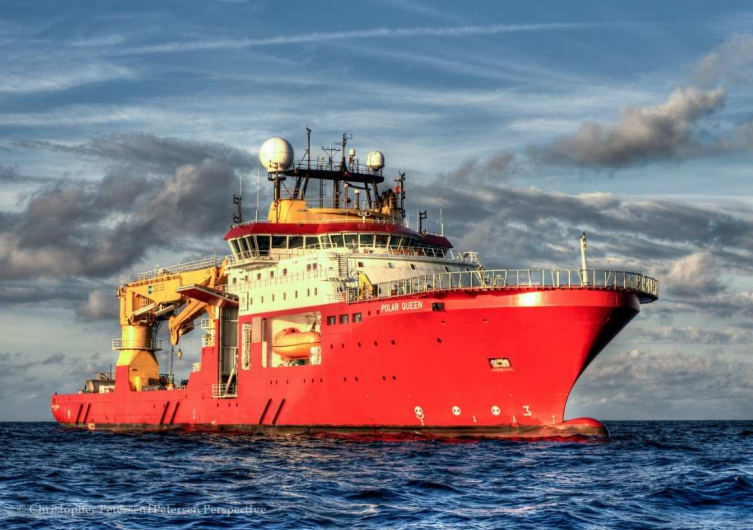
Schmidt Ocean Institue Names 10-Member Advisory Board
November 17, 2020
Schmidt Ocean Institute announced it has named a 10-member advisory board of international experts in science, maritime operations and communications.
The board members, who will serve three-year terms, will provide feedback and guidance on Schmidt Ocean’s strategy and operations as the organization expands its work advancing oceanographic research and broadly sharing discoveries and information about the ocean. More in the Press Release. 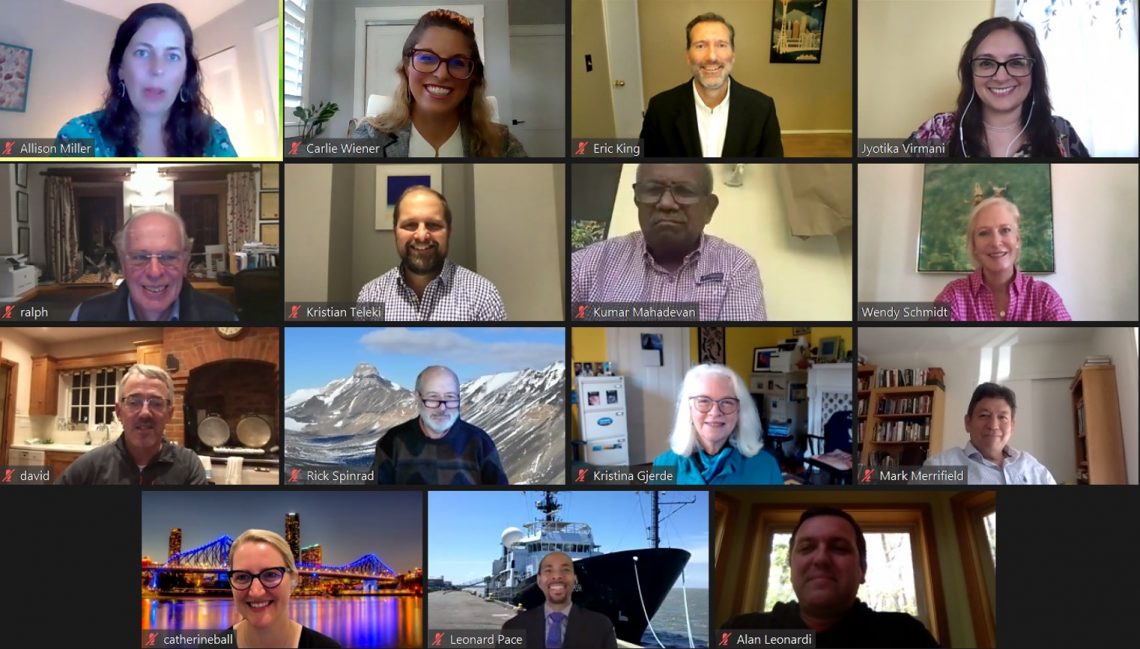
Article - First observation of Ram's Horn Squid in situ
November 2, 2020
For the first time ever, scientists have recorded footage of the ram’s horn squid, an enigma whose common shells—really their skeletons—have belied their vanishing secrecy.
Ram’s horn shells are small, delicate spiral structures beachcombers can commonly find throughout the world. Yet despite their ubiquity, the original owners of these shells are extremely elusive. Until now, researchers have never seen footage of even a single living example in the wild. This encounter has solved mysteries about the species behavior and physiology. More on the Science Alert website.
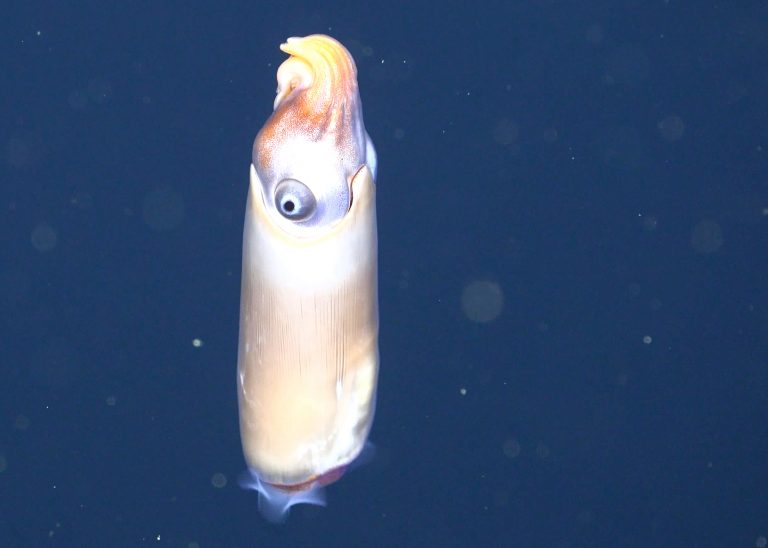
Article - New York Times Covers Siphonophore Discovery
April 2, 2020
This Might Be the Longest Creature Ever Seen in the Ocean – The New York Times has run an article about the #NingalooCanyons expedition.
“What’s fascinating about this particular part of the world is that it has not been explored,” said Jyotika Virmani, executive director of the Schmidt Ocean Institute. “Any time people go down into the deep sea, it’s so vast and yet so unexplored that it’s very easy to make new discoveries and to see something we’ve never seen before. It is like being on a new planet.”
Part of the goal of the expedition was to create a baseline understanding of the species there so that marine park rangers can know what they are protecting.”
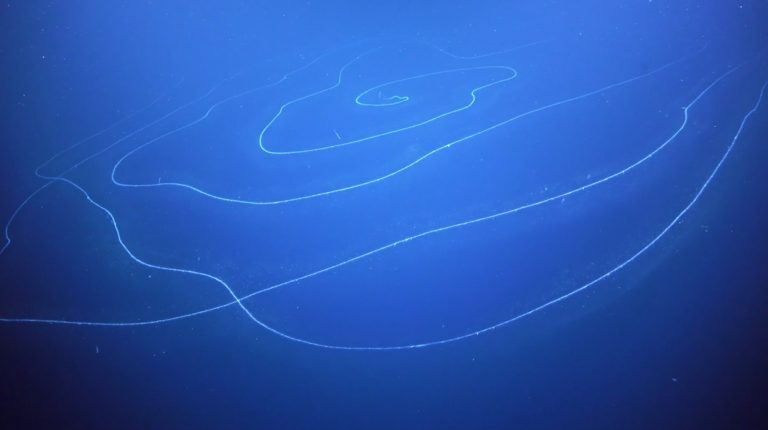
Article - ECO Magazine - Special Issue Dedicated to Deep Sea Research, Partnering with SOI
April 2, 2020
Available in November 2020, this exclusive edition will highlight the latest international research, groundbreaking expeditions, opportunities in science and industry, and developments in innovative deep-sea robots, vehicles and sensors.
“Our Deep Sea Special Issue joins a series of unique digital editions in 2020 that offer the global research community a unique platform to celebrate scientific progress and identify opportunities for collaboration,” said Kira Coley, ECO Magazine’s senior editor. “For this issue, we are thrilled to be partnering with two leading institutes in deep sea science, technology and exploration.”
Article - Marine Technology News - Schmidt Appoints Virmani as Executive Director
February 18, 2020
Marine Technology News reports on Schmidt Ocean Institute’s first Executive Director, Dr. Jyotika Virmani.
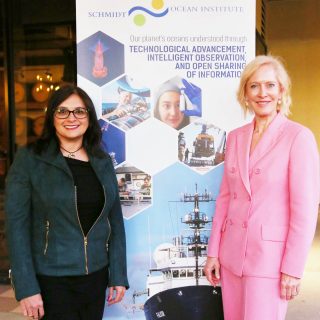
Global Initiative - Schmidt Ocean Institute Maps One Million Square Kilometers of Seafloor and Joins Monumental Mapping Initiative
December 9, 2019
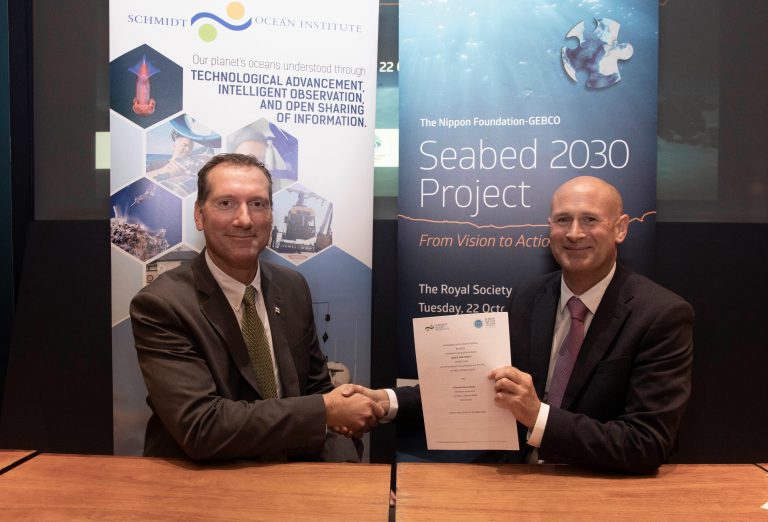
Schmidt Ocean Institute announced it has as come together with The Nippon Foundation-GEBCO Seabed 2030 Project for the joint signing of a Memorandum of Understanding to share all of its collected mapping data with the project. According to the Seabed 2030 Project, about 32 million square kilometers or 15% of the ocean has been mapped. The million square kilometer milestone is a big one for Schmidt Ocean, accounting for 3% of this mapping contribution and the discovery of 14 new underwater features.
The groups met at the Royal Society, making Schmidt Ocean one of more than 100 organizations to formally support the initiative. Seabed 2030 is a global initiative aimed at creating a detailed, freely available map of the entire ocean floor by the year 2030. GEBCO (General Bathymetric Chart of the Oceans) is the only organization with a mandate to map the ocean floor. Further information HERE.
Article - Knowable Magazine - A World in a Bottle of Water
August 02, 2019
Knowable Magazine article looks into revolutionary techniques using traces of environmental DNA being used to analyze entire ecosystems “from microbes to whales” – features imagery from the “Voyage to the White Shark Café” expedition.

Editorial Focus Article - Earth & Space Science News - Women in Oceanography Still Navigate Rough Seas
June 06, 2019
Earth & Space Science News article about challenges female scientists in oceanography face features many Principal Investigators and researchers who have sailed on R/V Falkor.
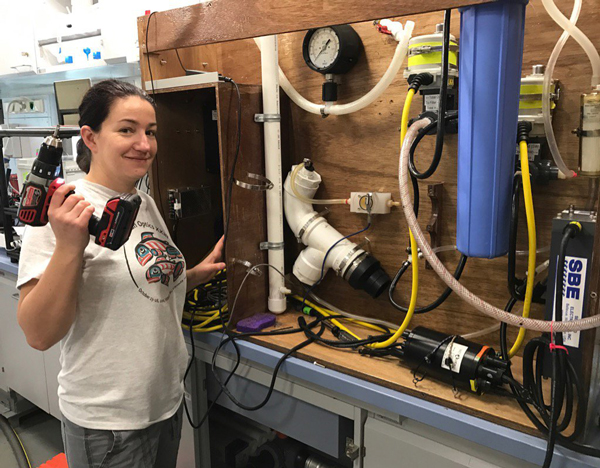
Global Initiative - United Nations Decade of Ocean Science for Sustainable Development
May 13-15, 2019
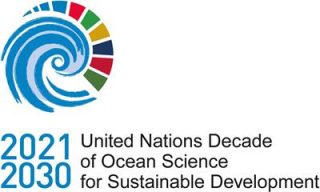
Schmidt Ocean Institute was proud to contribute to the first planning meeting for the UN Decade of Ocean Science. The Global Planning Meeting provided a forum to gather approximately 200 thought-leaders/champions/key stakeholders. A mixture of plenary and breakout groups facilitated international, interdisciplinary discussions across sectors (such as: ocean science and technology; ocean policy and sustainable development; business and industry; NGOs and civil society; donors and foundations) to identify concrete deliverables and partnerships to meet the Decade’s societal objectives.
The Global Planning Meeting offered a crucial opportunity to co-design mission-oriented research strategies in line with the 2030 Agenda, taking advantage of cross-cutting issues such as transforming knowledge systems; accelerating transfer of technology; enabling training and education; and fostering science-policy dialogues.
We look forward to working with the UN Decade Team to help implement goals. Learn more at the meeting’s webpage and the UN Decade For Ocean Sciences website.
Video of the session below:
Public Testimony - United States House of Representatives Committee on Science, Space and Technology, Environment Subcommittee, discussing Ocean Exploration
June 05, 2019
Schmidt Ocean Institute was invited to testify before the United States House of Representatives Committee on Science, Space and Technology, Environment Subcommittee to discuss Ocean Exploration. Dr. Carlie Wiener was selected to be one of four witnesses to discuss the current state of the U.S. ocean exploration enterprise (involving public, private and academic/non-profit), including recent discoveries, challenges and opportunities of exploring the oceans, technological innovations (e.g. ROV development) and research gaps.
This hearing allowed the congressional members of the subcommittee to hear how ocean exploration can benefit society, make observations of changes in ocean conditions, and to serve as a starting point for potential legislation.
R/V Falkor Finishes Shipyard - Heads to Sea
May 29, 2019
R/V Falkor departs Portland, heading down Columbia River, after a 60-day shipyard period. Up Next: a week of sea trials to test many of the upgrades to both the ship and Remotely Operated Vehicle SuBastian. After trials, The Seeking Space Rocks expedition team begins their search around the site of the March 2018 meteorite fall over the Olympic Coast National Marine Sanctuary.
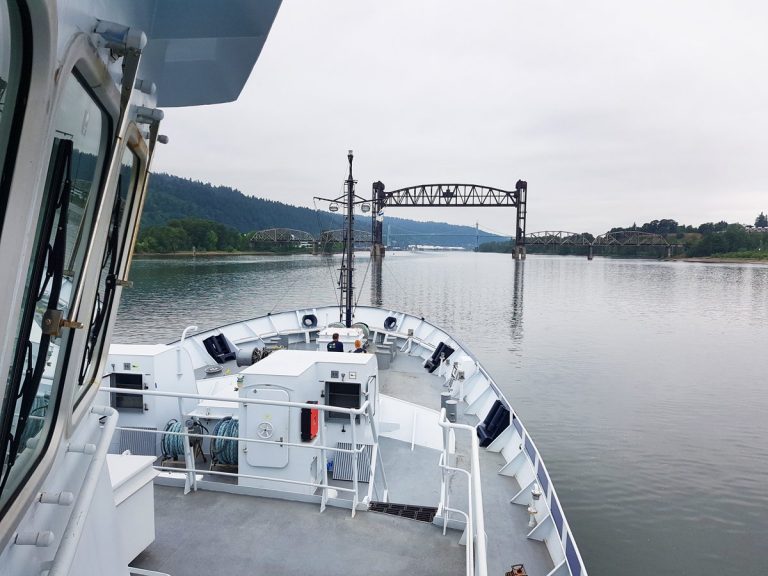
Editorial Focus Article - WIRED Magazine - SEAFLOOR MAPS REVEAL UNDERWATER CAVES, SLOPES—AND FAULT LINES
May 05, 2019
WIRED Magazine article about the importance and applications of seafloor mapping features images of ROV SuBastian and quotes from SOI team members.
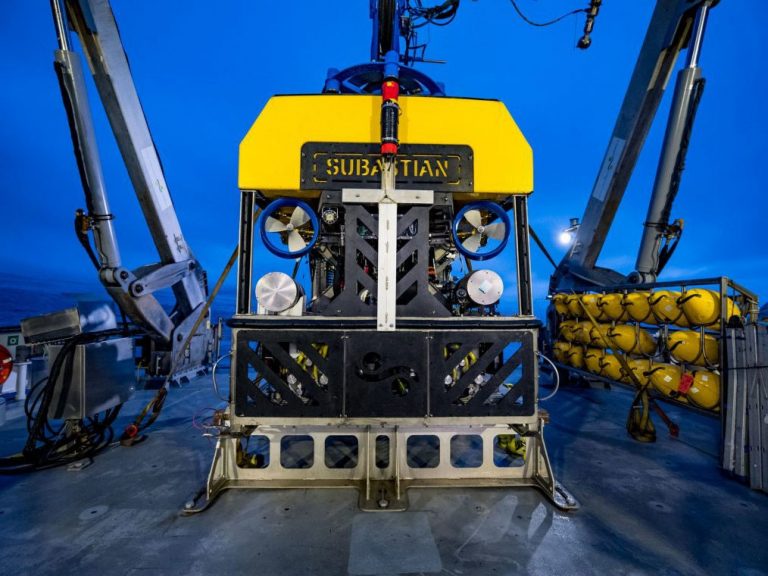
Hydrothermal vent and cold seep environments discoveries in Gulf of California
March/April, 2019
While exploring hydrothermal vent and cold seep environments during the Microbial Mysteries expedition, Dr. Mandy Joye (University of Georgia), and her interdisciplinary research team made several amazing discoveries, including discovered large venting mineral towers that reach up to 23 meters in height and 10 meters across. These towers featured numerous volcanic flanges that create the illusion of looking at a mirror when observing the superheated (366ºC) hydrothermal fluids beneath them. The minerals across the features were laden with metals and the fluids were highly sulfidic, yet these sites were teeming with biodiversity and potentially novel fauna.
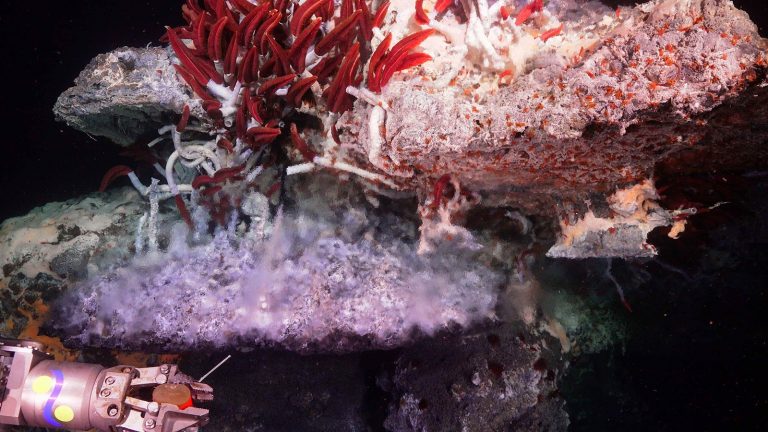
New Deep Sea Animal Discoveries Warrant Expanded Protections in Costa Rican Waters
January/February, 2019
Scientists aboard Schmidt Ocean Institute’s research vessel Falkor surveyed deep-sea seamounts outside Isla del Coco UNESCO World Heritage site revealing coral communities with surprising diversity during the “Costa Rican Deep Sea Connections” expedition.
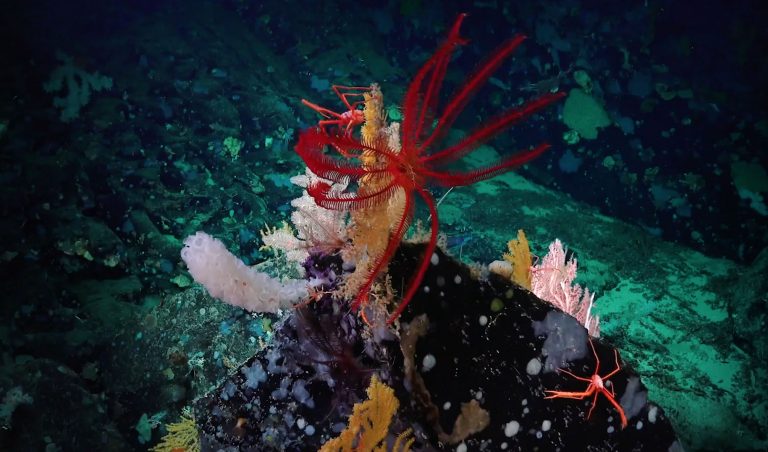
New Undersea Maps Lead to Hydrothermal Vent and Species Discoveries
November/December, 2018
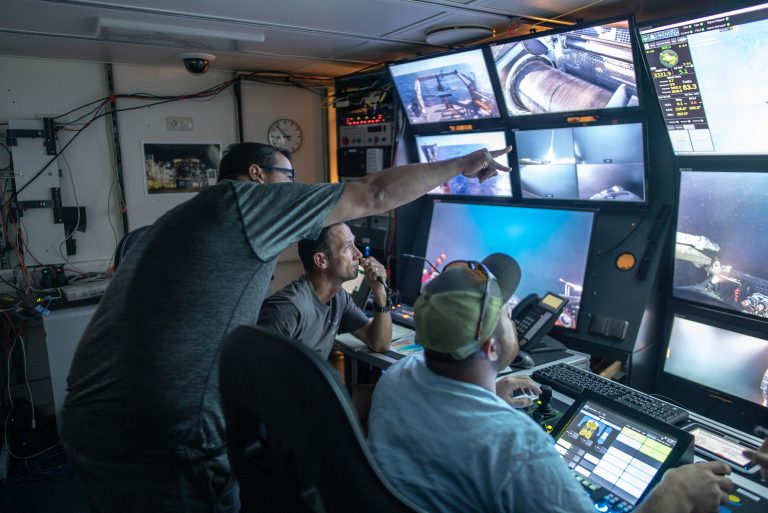
Autonomous and interactive robotic seafloor mapping systems were used on an expedition aboard research vessel Falkor in the southern Gulf of California, leading scientists to a new hydrothermal vent field and enabling the discovery of new deep-sea organisms.
Cover, Editorial Focus Article - ECO Magazine
November/December, 2018
The November/December issue of ECO Magazine features an image made by ROV SuBastian from the #DeepCoralsOfPIPA expedition on its cover. Additionally, the Editorial Focus Article is about research sponsored by Schmidt Ocean Institute this year: “Underwater Paradigm Shift: How advancing technologies are changing the way scientists study the ocean” (Begins on page 24).
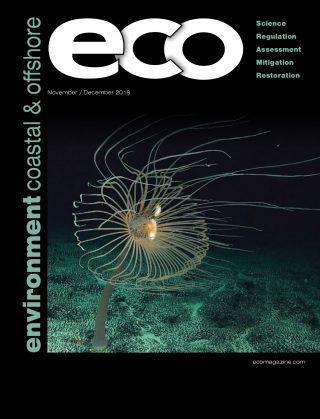
Seeker Media - Ep. 4: How Close Are We To Completely Mapping The Ocean?
November 24, 2018
Schmidt Ocean Institute features prominently in the Fourth Episode of Seeker Media’s video series “How Close are We?”, exploring how today’s discoveries in science, math, engineering, and technology are impacting humanity and shaping our future. The episode includes interviews, footage, and information from SOI staff and expeditions.
Artificial Intelligence Guides Exploration and one of the World’s Largest Multiresolution 3D Photogrammetric Reconstruction of Seafloor
August, 2018
Researchers aboard Schmidt Ocean Institute’s research vessel Falkor used autonomous underwater robots, along with the Institute’s remotely operated vehicle (ROV) SuBastian, to acquire 1.3 million high resolution images of the seafloor at Hydrate Ridge, composing them into the largest known high resolution color 3D model of the seafloor. Using unsupervised clustering algorithms, they identified dynamic biological hotspots in the image data for more detailed surveys and sampling by a remotely operated vehicle. More on the expedition website.
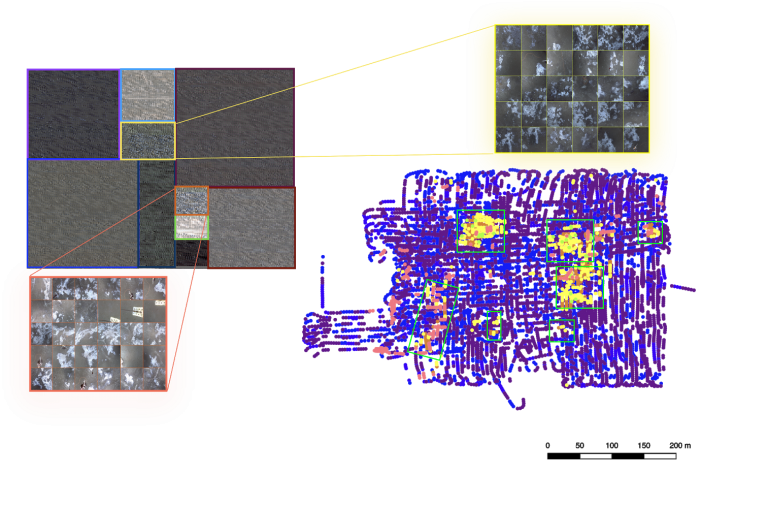
SOI one of MTR's ``Top 10`` Ocean Influencers
August 16, 2018
Schmidt Ocean Institute is featured in the 2018 Marine Technology Reporter 100, an annual showcase of innovators in the maritime industry, with an added honor of being named one of the Top 10 Ocean Influencers.
Fleet of Aerial, Surface and Underwater Robots Maps Ocean Front
June/July, 2018
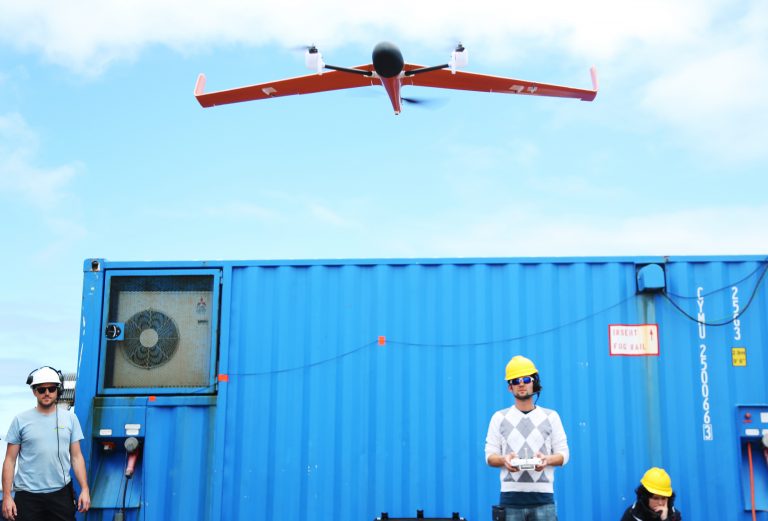
Using multiple autonomous vehicles simultaneously, an interdisciplinary team of scientists and engineers returns to the United States after exploring the North Pacific Subtropical front – a sharp boundary where cold fresh waters from the north meet warm salty waters from the south. The fronts are the most conspicuous oceanographic phenomena and the goal of this project was to demonstrate the use of distributed autonomous robotics to detect, track, and characterize these complex and dynamic processes with high accuracy across large spatial and temporal scales.
Scientists Voyage To The White Shark Café
May/June, 2018
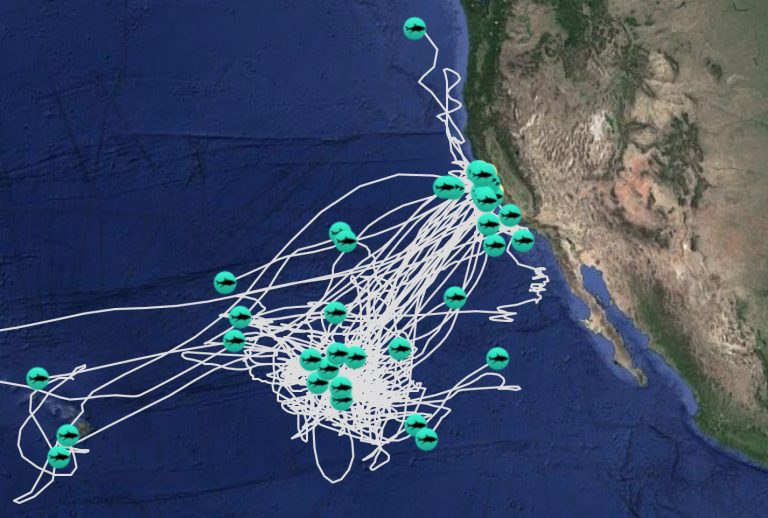
Scientists are a step closer to understanding what draws white sharks each spring to the “White Shark Café”, an offshore aggregation area halfway between Mexico and Hawaii in the Pacific. An interdisciplinary research team from five Institutions led by Stanford University Marine Biologist Dr. Barbara Block, has just completed a month-long expedition aboard Schmidt Ocean Institute’s research vessel Falkor. Using an array of cutting-edge and traditional oceanographic instruments, the scientists studied the Café ecosystem in unprecedented detail, yielding new insights into its appeal to these apex predators.
Deep-Sea Exploration Gives New Insight and Discoveries in Largest and Deepest UNESCO World Heritage Site
November, 2017
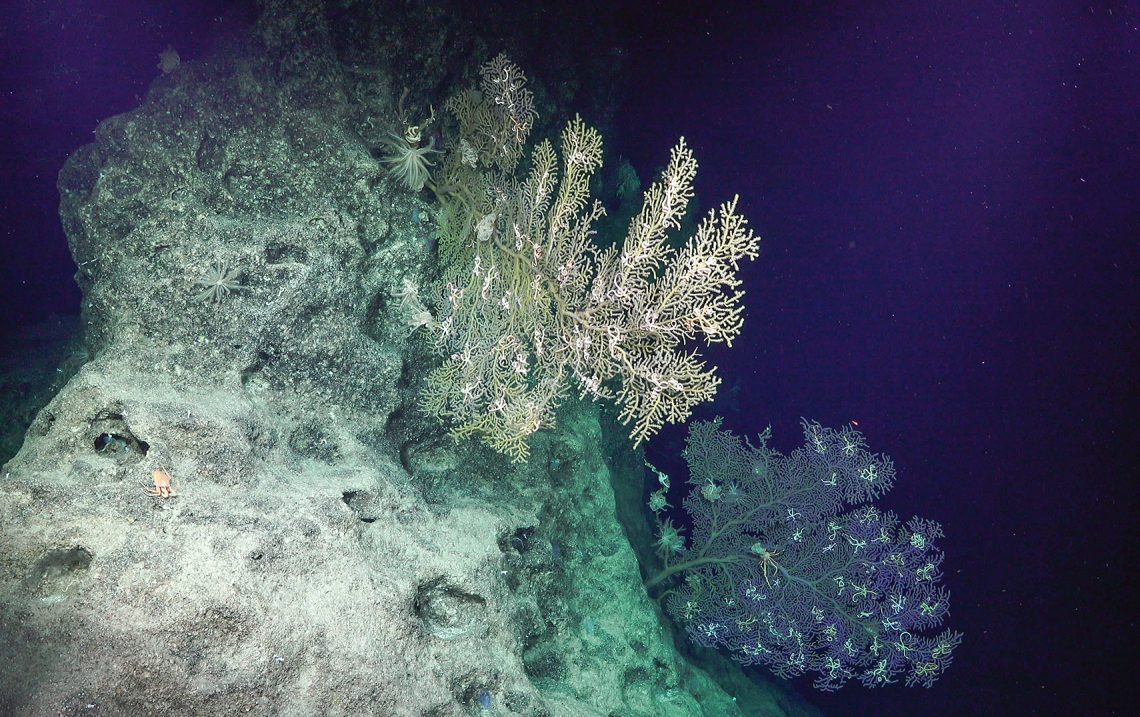
Seventeen underwater robotic dives have been made using ROV SuBastian, completing the first expedition of the islands and eastern seamounts of the Phoenix Islands Protected Area (PIPA) in the nation of Kiribati. This follows an initial exploration of the western seamounts by the NOAA Ship Okeanos Explorer. “This journey was in the tradition of the grand research expeditions of the past,” said Chief Scientist Dr. Erik Cordes from Temple University. “We traveled nearly 3,000 miles across the Pacific Ocean and explored a part of the world that has remained entirely hidden from view until now.” More information HERE.
Opening of Artist-at-Sea exhibit at Sail Newport, a collaboration with 11th Hour Racing
October 22nd, 2017
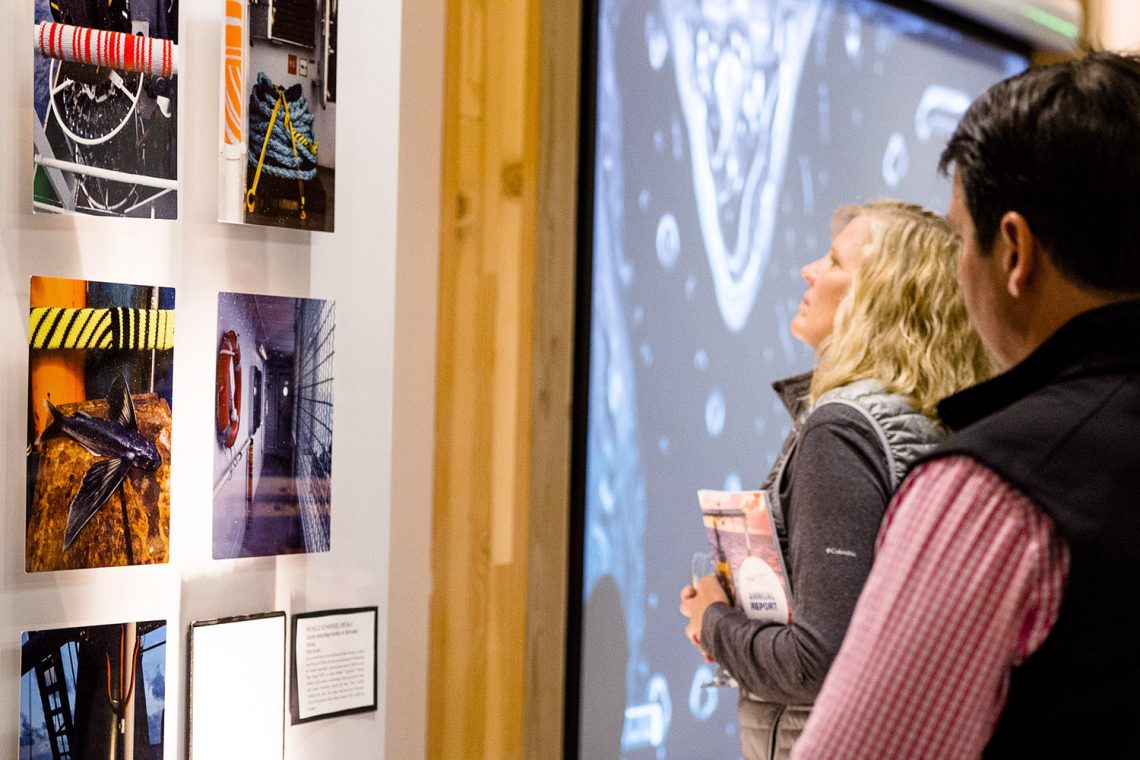
Sail Newport hosted the first east coast installation of Schmidt Ocean Institute’s traveling Artist-at-Sea exhibit, featuring work completed on research vessel Falkor. The traveling exhibit honors five years of cutting-edge research and contributions to the oceanographic community. For the first time, the unique traveling art exhibit made its way to the east coast of the United States, showcasing recent ocean science discoveries that shed new light on our oceans. The Artist-at-Sea program selects artists internationally with unique backgrounds to travel with ocean scientists on the vessel to create art that highlights the science and data collected at sea. The exhibit includes paintings, photography, fiber, and film inspired by the latest research exploring hydrothermal vents, coral reefs, and mapping of the ocean floor.
Falkor and Okeanos Public Tours in Honolulu
October, 2017
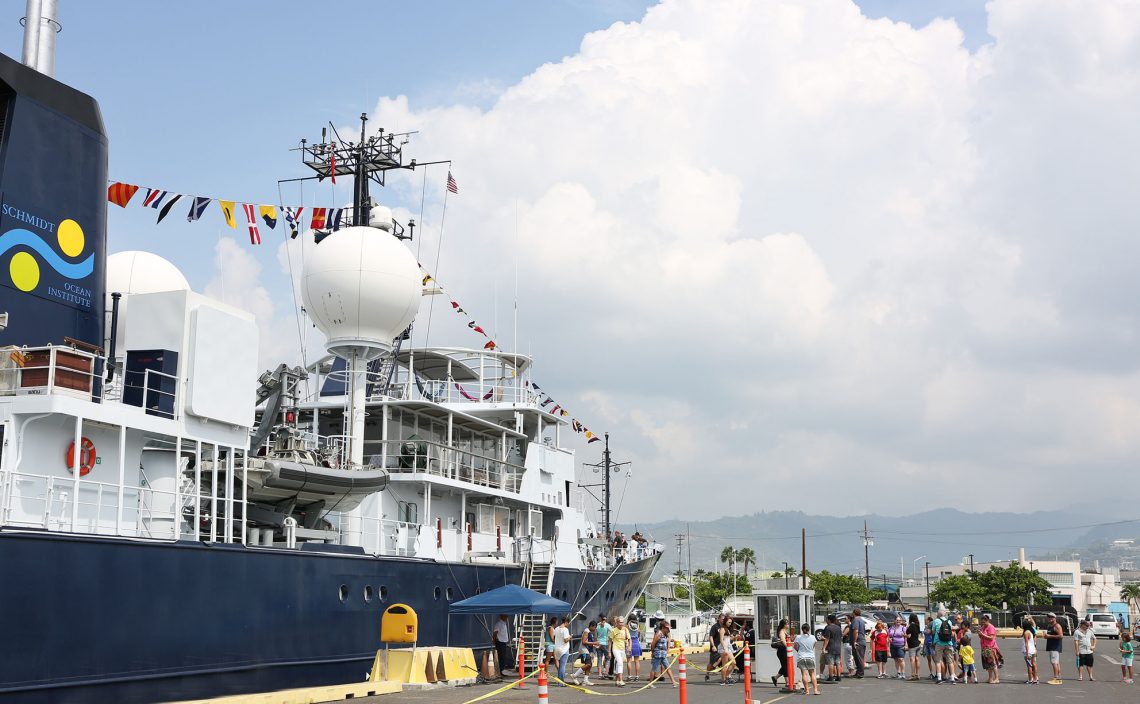
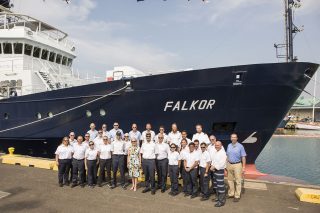 As part of the celebration for five years of research on board R/V Falkor, public ship tours were given on both NOAA Okeanos and Falkor at the Port of Honolulu. Hundreds of visitors were given a behind-the-scenes look at how the ship’s operated and insight into making science happen at sea. Other activities at the port included hands-on exhibits and presentations by researchers, as well as speeches by experts, including Co-Founder Wendy Schmidt.
As part of the celebration for five years of research on board R/V Falkor, public ship tours were given on both NOAA Okeanos and Falkor at the Port of Honolulu. Hundreds of visitors were given a behind-the-scenes look at how the ship’s operated and insight into making science happen at sea. Other activities at the port included hands-on exhibits and presentations by researchers, as well as speeches by experts, including Co-Founder Wendy Schmidt.
Schmidt Ocean Institute Impact Award presented to Dr. Christopher Zappa
October 3rd, 2017
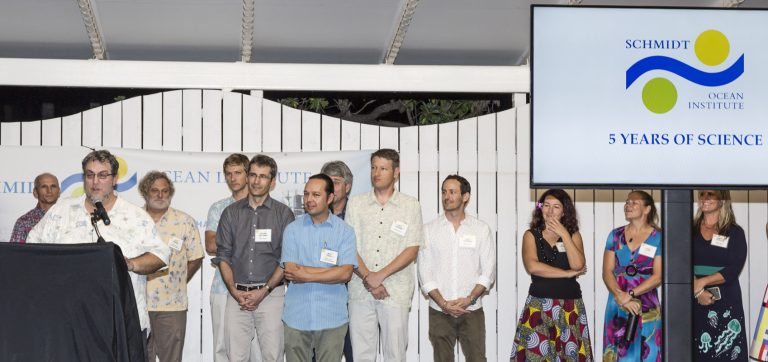
On October 3rd, 2017, Schmidt Ocean Institute presented the first Impact Award to Dr. Christopher Zappa at the celebration of five years of research on board Falkor. The Schmidt Ocean Institute Impact Award recognizes investigators who have sailed on research vessel Falkor and taken great risks to align their research with our mission, to transform ocean sciences with disruptive innovation and defy the conventions of what observations, data, and knowledge are attainable to scientists at sea. More information here.
SOI featured in MTR's Top 100 Innovators
August 18, 2017
Schmidt Ocean Institute is featured in the 2017 Marine Technology Reporter 100, an annual showcase of innovators in the maritime industry.
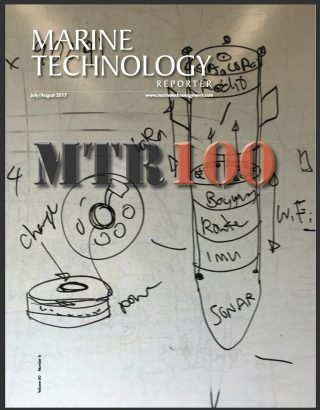
Expedition collaborating with NASA concludes
March 6, 2017
The Sea to Space Particle Investigation used multiple new instruments during a 25 day expedition across the Pacific exploring a wide variety of oceanic ecosystems. The focus of chief scientist Dr. Ivona Cetinic´, USRA/NASA, and her multidisciplinary team of oceanographers, engineers, biologists, and computer scientists was to explore ocean particles, and more specifically the tiny phytoplankton that make up the base of our food web. The team will use the collected information to ground-truth satellite observation of ocean color (influenced by phytoplankton), in order to better understand the processes each planktonic community carries out with regards to the carbon and nitrogen cycles.
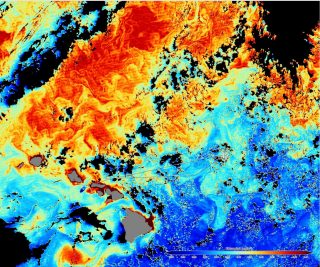
Mapping Reveals Evolution of Underwater Landscapes in the Johnston Atoll
January, 2017
Over 11,000 square kilometers of the ocean floor were mapped in high-resolution for the first time. Using multibeam sonar on RV Falkor, a team generated detailed maps of portions around the remote Johnston Atoll Unit (JAU) of the Pacific Remote Islands Marine National Monument (PRIMNM).
Artist-At-Sea Exhibit Opens in Honolulu, Hawaii
January, 2017
The first exhibit featuring a collection of work from the Artist-At-Sea program opens in Honolulu, Hawaii. The showcase of painting, photography, music and film is work from internationally recognized artists who have spent time aboard the research vessel Falkor. The exhibit travels through 2017, including shows at: Monterey Bay Aquarium Research Institute; America’s Cup Bermuda; Newport, Rhode Island; and the Bishop Museum in Honolulu, Hawaii.

ROV SuBastian Searches for Life in Hydrothermal Mariana
December, 2016
Remotely Operated Vehicle (ROV) SuBastian has a very successful first scientific cruise during the “Searching for Life in Hydrothermal Mariana” expedition, gathering samples and data around the Mariana Back-arc. The study also confirmed that the Back-Arc ecosystems are distinct and different from the nearby Volcanic Arc hydrothermal ecosystems, supporting the idea that geological and chemical environment play a key role in selecting animal community composition at hydrothermal vents.
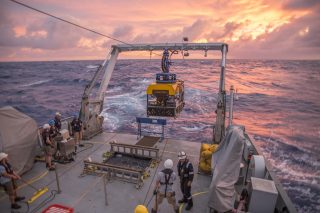
First Instance of UAV carrying scientific instruments flown from a ship without the help of a catapult or launching system
October, 2016
During the Study Of The Sea-Surface Microlayer and Air-Sea Boundary (2016) expedition, the HQ-60B model Unmanned Aerial Vehicle (UAV) completed its first science mission, taking instruments away from Falkor to undisturbed waters and bringing them back safely. This was the first time UAVs carrying scientific instruments were launched from a ship without the help of a catapult or launching system.
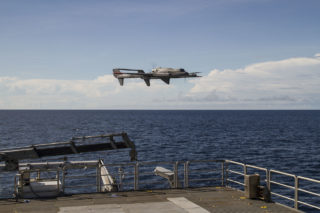
ROV SuBastian Completes Sea Trials
July, 2016
Remotely Operated Vehicle (ROV) SuBastian completes a month of rigorous tests in the open ocean off the island of Guam in the western Pacific. Schmidt Ocean Institute worked through the summer, testing and integrating the new ROV with research vessel Falkor.
ROV SuBastian Tank Testing at MBARI
April, 2016
Schmidt Ocean Institute’s 4,500m Remotely Operated Vehicle SuBastian undergoes Tank Testing at MBARI
Virtual Reality Technology Reveals Underwater Vents in New Ways
March, 2016
Scientists aboard R/V Falkor during the Virtual Vents expedition develop the first 3D model of an entire hydrothermal vent field for Virtual Reality, covering the largest area of seafloor ever imaged in such a manner.
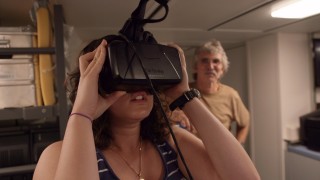
Exploring New Land Using High-Resolution 3D Mapping
May, 2016
The crew of Falkor teamed up with NASA and Columbia’s Lamont Doherty Earth Observatory to create an integrated view of the three dimensional character of the new island – from the seafloor to its approximately 130 meters tall summit above sea-level at a spectacular meter-scale resolution.
SOI discovery ``Engineers Ridge`` officially named
January, 2016
Named after the unsung heroes of science at sea who keep ships running, the underwater feature was discovered during an SOI science expedition in the Marianas Trench Marine National Monument in November 2014. R/V Falkor technicians mapped and measured Engineers Ridge at 4.5 kilometers x 3 km (99 miles x 1.86 miles) and a maximum depth of 4,100 meters.
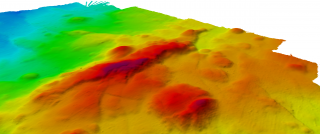
Artist-At-Sea program launched
December, 2015
During a transit from Guam to Honolulu, Leslie Reed is the first Artist-at-Sea participant to journey on R/V Falkor, making photographic imagery that is influenced by the content and pH of the seawater where the exposure was made.
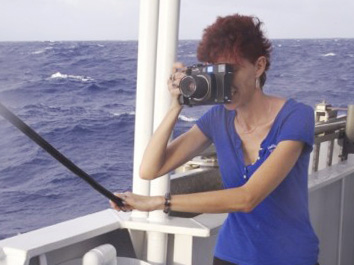
Several Hydrothermal Vent Sites Discovered
December, 2015
The Hydrothermal Hunt at Mariana expedition onboard R/V Falkor more than doubled the number of known hydrothermal vent sites in the Mariana Back-arc region. Another highlight was the discovery of an extremely rare, recently-erupted underwater lava field that was likely only a few months old.
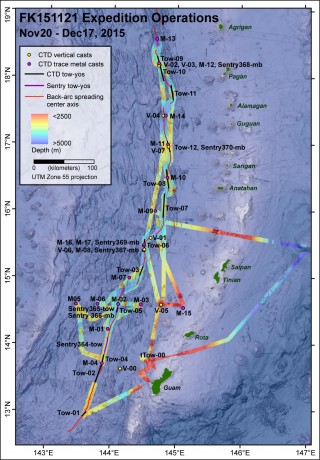
SOI Selected As Top Innovator
July/ August, 2015
Schmidt Ocean Institute is selected as the Editor’s Choice top Five Stand-Outs in the Marine Technology Reporter’s annual Top 100 innovators in the maritime industry.
SOI Holds Their Second Research Planning Workshop
August, 2015
Schmidt Ocean Institute holds its second Research Planning Workshop “Transforming Seagoing Science with Robotic Platforms, Innovative Software Engineering, and Data Analytics”.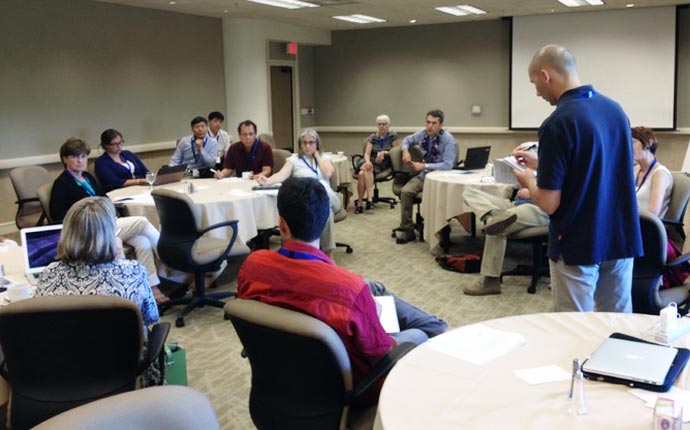
Falkor’s First Seismic Profiling Cruise
June, 2015
Falkor conducts her first seismic profiling cruise in Indonesia, acquiring 17,597 square kilometers of high-resolution maps of the Mentawai Gap off the west coast of Sumatra. These maps allow scientists to better model potential tsunami impacts produced by an expected underwater earthquake in this region.
Summary video:
In the News
ROV Dives at Scott Reef
May, 2015
A cruise aboard Falkor collects high resolution data on the physical and biological dynamics of Scott Reef in the Timor Sea using Falkor’s 300 meters depth remotely operated vehicle. All 16 of the dives totaling 77 hours are broadcast live from the ship to Schmidt Ocean Institute’s YouTube channel.
Highlights video:
In the News
Development of New Robot Tracking Tool
April, 2015
A new visualization tool for tracking multiple vehicles is developed aboard Falkor by the Australian Centre for Field Robotics (ACFR) so anyone can view robotic deployments in real time from a smartphone. Collected images using the robots are uploaded to a citizen science photo tagging project, where over 22,569 reef images are tagged by the public.
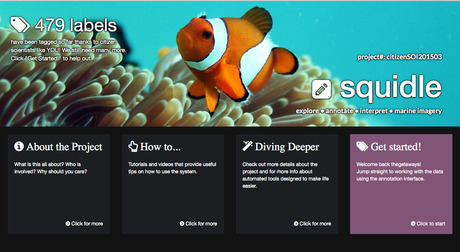
Coordinated Robotics Cruise
April, 2015
Eight underwater and surface robotic vehicles are deployed simultaneously off of Falkor as part of the first coordinated robotics in the Timor Sea of the northwest corner of Australia. This cruise allows engineers from the Australian School of Field Robotics to build towards leaving groups of robotic vehicles unattended to accomplish tasks such as seafloor mapping.
In the News
First Ever ROV Survey of Perth Canyon
March, 2015
Schmidt Ocean Institute hosts aboard Falkor the first remotely operated vehicle survey of Perth Canyon off Perth, Australia to conduct baseline studies of deep corals. New coral species are discovered and many organisms are observed in Western Australian waters for the first time.
In the News
Installation of First High-Performance Computer on a Research Vessel
January, 2015
Schmidt Ocean Institute installs the first high-performance cloud computing system on an oceanographic research vessel that will enable data storage and processing capabilities not previously available to scientists at sea.
Discovery of World’s Deepest Fish
November, 2014
Scientists on Falkor discover the world’s deepest known fish, among several other new species in the Mariana Trench, using Schmidt Ocean Institute’s full ocean depth free-falling landers.
Video of the new fish:
In the News
First Research Planning Workshop
August, 2014
Schmidt Ocean Institute’s first Research Planning Workshop “Critical Opportunities for Technologically Advanced Shipboard Oceanography in the Next 3-5 Years” is held in Hawaii.
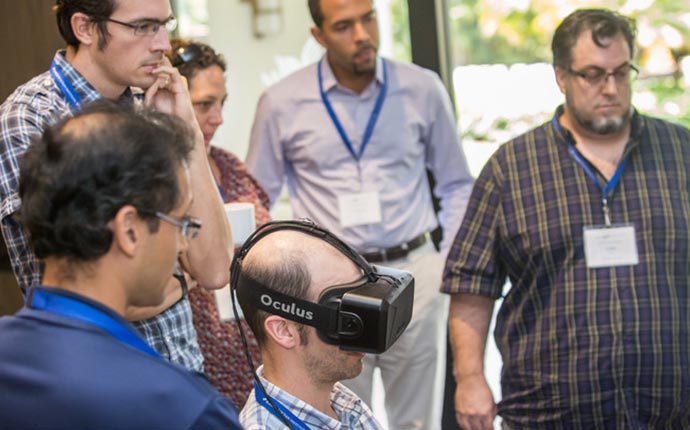
Falkor’s Maps One of the World's Largest Marine Protected Areas
March-June, 2014
Falkor maps 127,000 square kilometers of the Papahanaumokuakea Marine National Monument, about 35% of one of the world’s largest marine protected areas. These bathymetric maps are later used for remotely operated vehicle dives where several new fish and invertebrate species are found.
First Student Cruise
February-June, 2014
A student cruise program is launched with Schmidt Ocean Institute hosting three student-led cruises in collaboration with the University of Hawaii aboard the Falkor.
In the News
First Research Symposium
Falkor’s First Visit to San Francisco
July 28, 2013
Falkor arrives in the Port of San Francisco, calling on the interactive learning laboratory museum Exploratorium.
HROV Nereus is Used on Falkor
June, 2013
For the first time, hybrid remotely operated vehicle Nereus from Woods Hole Oceanographic Institute, is deployed in support of an oceanographic research project – exploring hydrothermal vent fields at the Mid-Cayman Rise. All dive videos are live streamed and recorded in perpetuity on YouTube.
In the News
First Maps of Campeche Escarpment
March, 2013
For the first time, over 20,000 square kilometers of the largest geological feature in the Gulf of Mexico, Campeche Escarpment, are mapped with Falkor.
First Year of Scientific Operations
2013
Schmidt Ocean Institute’s first full year of committed scientific operations, Falkor transits over 11,000 nautical miles throughout the Gulf of Mexico, Caribbean Sea and Pacific Ocean.
Science Verification Cruises
April-December, 2012
Extensive sea trials and science verification cruises conducted on Falkor to test and calibrate embedded systems and scientific equipment. Trials and cruises took place across the Atlantic Ocean from Germany to Norway, across the Atlantic Ocean, down the east coast of the United States and into the Gulf of Mexico.
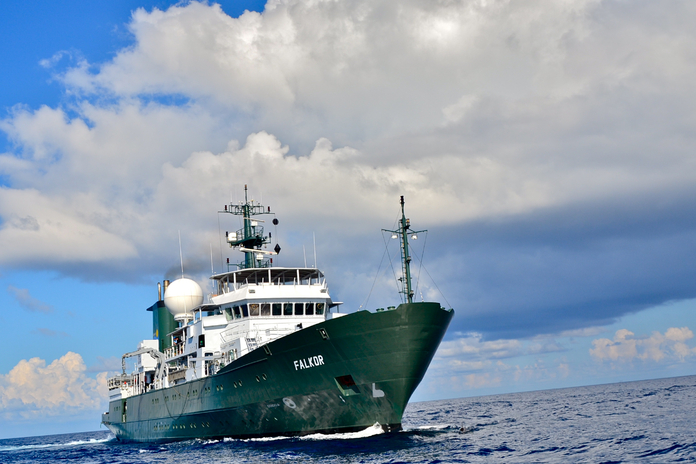
Falkor is Named
March 6, 2012
Falkor officially receives her new name in a re-naming ceremony at the Peters Schiffbau Shipyard in Wewelsfleth, Germany.
Remarks on renaming by Eric Schmidt:
Remarks on renaming by Wendy Schmidt:
Falkor Refit
2009 – 2012
Schmidt Ocean Institute purchases a German fisheries protection vessel, and undergoes an extensive refit to convert the ship to a state-of-the-art oceanographic research vessel, now known as Falkor.
In the News
SOI Begins
2009
Founders Eric and Wendy Schmidt establish Schmidt Ocean Institute as a 501 (c)(3) private non-profit operating foundation.
In the News
Article - New York Times Covers Siphonophore Discovery
April 2, 2020
This Might Be the Longest Creature Ever Seen in the Ocean – The New York Times has run an article about the #NingalooCanyons expedition.
“What’s fascinating about this particular part of the world is that it has not been explored,” said Jyotika Virmani, executive director of the Schmidt Ocean Institute. “Any time people go down into the deep sea, it’s so vast and yet so unexplored that it’s very easy to make new discoveries and to see something we’ve never seen before. It is like being on a new planet.”
Part of the goal of the expedition was to create a baseline understanding of the species there so that marine park rangers can know what they are protecting.”

Article - ECO Magazine - Special Issue Dedicated to Deep Sea Research, Partnering with SOI
April 2, 2020
Available in November 2020, this exclusive edition will highlight the latest international research, groundbreaking expeditions, opportunities in science and industry, and developments in innovative deep-sea robots, vehicles and sensors.
“Our Deep Sea Special Issue joins a series of unique digital editions in 2020 that offer the global research community a unique platform to celebrate scientific progress and identify opportunities for collaboration,” said Kira Coley, ECO Magazine’s senior editor. “For this issue, we are thrilled to be partnering with two leading institutes in deep sea science, technology and exploration.”
Article - Marine Technology News - Schmidt Appoints Virmani as Executive Director
February 18, 2020
Marine Technology News reports on Schmidt Ocean Institute’s first Executive Director, Dr. Jyotika Virmani.

Global Initiative - Schmidt Ocean Institute Maps One Million Square Kilometers of Seafloor and Joins Monumental Mapping Initiative
December 9, 2019

Schmidt Ocean Institute announced it has as come together with The Nippon Foundation-GEBCO Seabed 2030 Project for the joint signing of a Memorandum of Understanding to share all of its collected mapping data with the project. According to the Seabed 2030 Project, about 32 million square kilometers or 15% of the ocean has been mapped. The million square kilometer milestone is a big one for Schmidt Ocean, accounting for 3% of this mapping contribution and the discovery of 14 new underwater features.
The groups met at the Royal Society, making Schmidt Ocean one of more than 100 organizations to formally support the initiative. Seabed 2030 is a global initiative aimed at creating a detailed, freely available map of the entire ocean floor by the year 2030. GEBCO (General Bathymetric Chart of the Oceans) is the only organization with a mandate to map the ocean floor. Further information HERE.
Article - Knowable Magazine - A World in a Bottle of Water
August 02, 2019
Knowable Magazine article looks into revolutionary techniques using traces of environmental DNA being used to analyze entire ecosystems “from microbes to whales” – features imagery from the “Voyage to the White Shark Café” expedition.

Editorial Focus Article - Earth & Space Science News - Women in Oceanography Still Navigate Rough Seas
June 06, 2019
Earth & Space Science News article about challenges female scientists in oceanography face features many Principal Investigators and researchers who have sailed on R/V Falkor.

Global Initiative - United Nations Decade of Ocean Science for Sustainable Development
May 13-15, 2019

Schmidt Ocean Institute was proud to contribute to the first planning meeting for the UN Decade of Ocean Science. The Global Planning Meeting provided a forum to gather approximately 200 thought-leaders/champions/key stakeholders. A mixture of plenary and breakout groups facilitated international, interdisciplinary discussions across sectors (such as: ocean science and technology; ocean policy and sustainable development; business and industry; NGOs and civil society; donors and foundations) to identify concrete deliverables and partnerships to meet the Decade’s societal objectives.
The Global Planning Meeting offered a crucial opportunity to co-design mission-oriented research strategies in line with the 2030 Agenda, taking advantage of cross-cutting issues such as transforming knowledge systems; accelerating transfer of technology; enabling training and education; and fostering science-policy dialogues.
We look forward to working with the UN Decade Team to help implement goals. Learn more at the meeting’s webpage and the UN Decade For Ocean Sciences website.
Video of the session below:
Public Testimony - United States House of Representatives Committee on Science, Space and Technology, Environment Subcommittee, discussing Ocean Exploration
June 05, 2019
Schmidt Ocean Institute was invited to testify before the United States House of Representatives Committee on Science, Space and Technology, Environment Subcommittee to discuss Ocean Exploration. Dr. Carlie Wiener was selected to be one of four witnesses to discuss the current state of the U.S. ocean exploration enterprise (involving public, private and academic/non-profit), including recent discoveries, challenges and opportunities of exploring the oceans, technological innovations (e.g. ROV development) and research gaps.
This hearing allowed the congressional members of the subcommittee to hear how ocean exploration can benefit society, make observations of changes in ocean conditions, and to serve as a starting point for potential legislation.
R/V Falkor Finishes Shipyard - Heads to Sea
May 29, 2019
R/V Falkor departs Portland, heading down Columbia River, after a 60-day shipyard period. Up Next: a week of sea trials to test many of the upgrades to both the ship and Remotely Operated Vehicle SuBastian. After trials, The Seeking Space Rocks expedition team begins their search around the site of the March 2018 meteorite fall over the Olympic Coast National Marine Sanctuary.

Editorial Focus Article - WIRED Magazine - SEAFLOOR MAPS REVEAL UNDERWATER CAVES, SLOPES—AND FAULT LINES
May 05, 2019
WIRED Magazine article about the importance and applications of seafloor mapping features images of ROV SuBastian and quotes from SOI team members.

Hydrothermal vent and cold seep environments discoveries in Gulf of California
March/April, 2019
While exploring hydrothermal vent and cold seep environments during the Microbial Mysteries expedition, Dr. Mandy Joye (University of Georgia), and her interdisciplinary research team made several amazing discoveries, including discovered large venting mineral towers that reach up to 23 meters in height and 10 meters across. These towers featured numerous volcanic flanges that create the illusion of looking at a mirror when observing the superheated (366ºC) hydrothermal fluids beneath them. The minerals across the features were laden with metals and the fluids were highly sulfidic, yet these sites were teeming with biodiversity and potentially novel fauna.

New Deep Sea Animal Discoveries Warrant Expanded Protections in Costa Rican Waters
January/February, 2019
Scientists aboard Schmidt Ocean Institute’s research vessel Falkor surveyed deep-sea seamounts outside Isla del Coco UNESCO World Heritage site revealing coral communities with surprising diversity during the “Costa Rican Deep Sea Connections” expedition.

New Undersea Maps Lead to Hydrothermal Vent and Species Discoveries
November/December, 2018

Autonomous and interactive robotic seafloor mapping systems were used on an expedition aboard research vessel Falkor in the southern Gulf of California, leading scientists to a new hydrothermal vent field and enabling the discovery of new deep-sea organisms.
Cover, Editorial Focus Article - ECO Magazine
November/December, 2018
The November/December issue of ECO Magazine features an image made by ROV SuBastian from the #DeepCoralsOfPIPA expedition on its cover. Additionally, the Editorial Focus Article is about research sponsored by Schmidt Ocean Institute this year: “Underwater Paradigm Shift: How advancing technologies are changing the way scientists study the ocean” (Begins on page 24).

Seeker Media - Ep. 4: How Close Are We To Completely Mapping The Ocean?
November 24, 2018
Schmidt Ocean Institute features prominently in the Fourth Episode of Seeker Media’s video series “How Close are We?”, exploring how today’s discoveries in science, math, engineering, and technology are impacting humanity and shaping our future. The episode includes interviews, footage, and information from SOI staff and expeditions.
Artificial Intelligence Guides Exploration and one of the World’s Largest Multiresolution 3D Photogrammetric Reconstruction of Seafloor
August, 2018
Researchers aboard Schmidt Ocean Institute’s research vessel Falkor used autonomous underwater robots, along with the Institute’s remotely operated vehicle (ROV) SuBastian, to acquire 1.3 million high resolution images of the seafloor at Hydrate Ridge, composing them into the largest known high resolution color 3D model of the seafloor. Using unsupervised clustering algorithms, they identified dynamic biological hotspots in the image data for more detailed surveys and sampling by a remotely operated vehicle. More on the expedition website.

SOI one of MTR's ``Top 10`` Ocean Influencers
August 16, 2018
Schmidt Ocean Institute is featured in the 2018 Marine Technology Reporter 100, an annual showcase of innovators in the maritime industry, with an added honor of being named one of the Top 10 Ocean Influencers.
Fleet of Aerial, Surface and Underwater Robots Maps Ocean Front
June/July, 2018

Using multiple autonomous vehicles simultaneously, an interdisciplinary team of scientists and engineers returns to the United States after exploring the North Pacific Subtropical front – a sharp boundary where cold fresh waters from the north meet warm salty waters from the south. The fronts are the most conspicuous oceanographic phenomena and the goal of this project was to demonstrate the use of distributed autonomous robotics to detect, track, and characterize these complex and dynamic processes with high accuracy across large spatial and temporal scales.
Scientists Voyage To The White Shark Café
May/June, 2018

Scientists are a step closer to understanding what draws white sharks each spring to the “White Shark Café”, an offshore aggregation area halfway between Mexico and Hawaii in the Pacific. An interdisciplinary research team from five Institutions led by Stanford University Marine Biologist Dr. Barbara Block, has just completed a month-long expedition aboard Schmidt Ocean Institute’s research vessel Falkor. Using an array of cutting-edge and traditional oceanographic instruments, the scientists studied the Café ecosystem in unprecedented detail, yielding new insights into its appeal to these apex predators.
Deep-Sea Exploration Gives New Insight and Discoveries in Largest and Deepest UNESCO World Heritage Site
November, 2017

Seventeen underwater robotic dives have been made using ROV SuBastian, completing the first expedition of the islands and eastern seamounts of the Phoenix Islands Protected Area (PIPA) in the nation of Kiribati. This follows an initial exploration of the western seamounts by the NOAA Ship Okeanos Explorer. “This journey was in the tradition of the grand research expeditions of the past,” said Chief Scientist Dr. Erik Cordes from Temple University. “We traveled nearly 3,000 miles across the Pacific Ocean and explored a part of the world that has remained entirely hidden from view until now.” More information HERE.
Opening of Artist-at-Sea exhibit at Sail Newport, a collaboration with 11th Hour Racing
October 22nd, 2017

Sail Newport hosted the first east coast installation of Schmidt Ocean Institute’s traveling Artist-at-Sea exhibit, featuring work completed on research vessel Falkor. The traveling exhibit honors five years of cutting-edge research and contributions to the oceanographic community. For the first time, the unique traveling art exhibit made its way to the east coast of the United States, showcasing recent ocean science discoveries that shed new light on our oceans. The Artist-at-Sea program selects artists internationally with unique backgrounds to travel with ocean scientists on the vessel to create art that highlights the science and data collected at sea. The exhibit includes paintings, photography, fiber, and film inspired by the latest research exploring hydrothermal vents, coral reefs, and mapping of the ocean floor.
Falkor and Okeanos Public Tours in Honolulu
October, 2017

 As part of the celebration for five years of research on board R/V Falkor, public ship tours were given on both NOAA Okeanos and Falkor at the Port of Honolulu. Hundreds of visitors were given a behind-the-scenes look at how the ship’s operated and insight into making science happen at sea. Other activities at the port included hands-on exhibits and presentations by researchers, as well as speeches by experts, including Co-Founder Wendy Schmidt.
As part of the celebration for five years of research on board R/V Falkor, public ship tours were given on both NOAA Okeanos and Falkor at the Port of Honolulu. Hundreds of visitors were given a behind-the-scenes look at how the ship’s operated and insight into making science happen at sea. Other activities at the port included hands-on exhibits and presentations by researchers, as well as speeches by experts, including Co-Founder Wendy Schmidt.
Schmidt Ocean Institute Impact Award presented to Dr. Christopher Zappa
October 3rd, 2017

On October 3rd, 2017, Schmidt Ocean Institute presented the first Impact Award to Dr. Christopher Zappa at the celebration of five years of research on board Falkor. The Schmidt Ocean Institute Impact Award recognizes investigators who have sailed on research vessel Falkor and taken great risks to align their research with our mission, to transform ocean sciences with disruptive innovation and defy the conventions of what observations, data, and knowledge are attainable to scientists at sea. More information here.
SOI featured in MTR's Top 100 Innovators
August 18, 2017
Schmidt Ocean Institute is featured in the 2017 Marine Technology Reporter 100, an annual showcase of innovators in the maritime industry.

Expedition collaborating with NASA concludes
March 6, 2017
The Sea to Space Particle Investigation used multiple new instruments during a 25 day expedition across the Pacific exploring a wide variety of oceanic ecosystems. The focus of chief scientist Dr. Ivona Cetinic´, USRA/NASA, and her multidisciplinary team of oceanographers, engineers, biologists, and computer scientists was to explore ocean particles, and more specifically the tiny phytoplankton that make up the base of our food web. The team will use the collected information to ground-truth satellite observation of ocean color (influenced by phytoplankton), in order to better understand the processes each planktonic community carries out with regards to the carbon and nitrogen cycles.

Mapping Reveals Evolution of Underwater Landscapes in the Johnston Atoll
January, 2017
Over 11,000 square kilometers of the ocean floor were mapped in high-resolution for the first time. Using multibeam sonar on RV Falkor, a team generated detailed maps of portions around the remote Johnston Atoll Unit (JAU) of the Pacific Remote Islands Marine National Monument (PRIMNM).
Artist-At-Sea Exhibit Opens in Honolulu, Hawaii
January, 2017
The first exhibit featuring a collection of work from the Artist-At-Sea program opens in Honolulu, Hawaii. The showcase of painting, photography, music and film is work from internationally recognized artists who have spent time aboard the research vessel Falkor. The exhibit travels through 2017, including shows at: Monterey Bay Aquarium Research Institute; America’s Cup Bermuda; Newport, Rhode Island; and the Bishop Museum in Honolulu, Hawaii.

ROV SuBastian Searches for Life in Hydrothermal Mariana
December, 2016
Remotely Operated Vehicle (ROV) SuBastian has a very successful first scientific cruise during the “Searching for Life in Hydrothermal Mariana” expedition, gathering samples and data around the Mariana Back-arc. The study also confirmed that the Back-Arc ecosystems are distinct and different from the nearby Volcanic Arc hydrothermal ecosystems, supporting the idea that geological and chemical environment play a key role in selecting animal community composition at hydrothermal vents.

First Instance of UAV carrying scientific instruments flown from a ship without the help of a catapult or launching system
October, 2016
During the Study Of The Sea-Surface Microlayer and Air-Sea Boundary (2016) expedition, the HQ-60B model Unmanned Aerial Vehicle (UAV) completed its first science mission, taking instruments away from Falkor to undisturbed waters and bringing them back safely. This was the first time UAVs carrying scientific instruments were launched from a ship without the help of a catapult or launching system.

ROV SuBastian Completes Sea Trials
July, 2016
Remotely Operated Vehicle (ROV) SuBastian completes a month of rigorous tests in the open ocean off the island of Guam in the western Pacific. Schmidt Ocean Institute worked through the summer, testing and integrating the new ROV with research vessel Falkor.
ROV SuBastian Tank Testing at MBARI
April, 2016
Schmidt Ocean Institute’s 4,500m Remotely Operated Vehicle SuBastian undergoes Tank Testing at MBARI
Virtual Reality Technology Reveals Underwater Vents in New Ways
March, 2016
Scientists aboard R/V Falkor during the Virtual Vents expedition develop the first 3D model of an entire hydrothermal vent field for Virtual Reality, covering the largest area of seafloor ever imaged in such a manner.

Exploring New Land Using High-Resolution 3D Mapping
May, 2016
The crew of Falkor teamed up with NASA and Columbia’s Lamont Doherty Earth Observatory to create an integrated view of the three dimensional character of the new island – from the seafloor to its approximately 130 meters tall summit above sea-level at a spectacular meter-scale resolution.
SOI discovery ``Engineers Ridge`` officially named
January, 2016
Named after the unsung heroes of science at sea who keep ships running, the underwater feature was discovered during an SOI science expedition in the Marianas Trench Marine National Monument in November 2014. R/V Falkor technicians mapped and measured Engineers Ridge at 4.5 kilometers x 3 km (99 miles x 1.86 miles) and a maximum depth of 4,100 meters.

Artist-At-Sea program launched
December, 2015
During a transit from Guam to Honolulu, Leslie Reed is the first Artist-at-Sea participant to journey on R/V Falkor, making photographic imagery that is influenced by the content and pH of the seawater where the exposure was made.

Several Hydrothermal Vent Sites Discovered
December, 2015
The Hydrothermal Hunt at Mariana expedition onboard R/V Falkor more than doubled the number of known hydrothermal vent sites in the Mariana Back-arc region. Another highlight was the discovery of an extremely rare, recently-erupted underwater lava field that was likely only a few months old.

SOI Selected As Top Innovator
July/ August, 2015
Schmidt Ocean Institute is selected as the Editor’s Choice top Five Stand-Outs in the Marine Technology Reporter’s annual Top 100 innovators in the maritime industry.
SOI Holds Their Second Research Planning Workshop
August, 2015
Schmidt Ocean Institute holds its second Research Planning Workshop “Transforming Seagoing Science with Robotic Platforms, Innovative Software Engineering, and Data Analytics”.
Falkor’s First Seismic Profiling Cruise
June, 2015
Falkor conducts her first seismic profiling cruise in Indonesia, acquiring 17,597 square kilometers of high-resolution maps of the Mentawai Gap off the west coast of Sumatra. These maps allow scientists to better model potential tsunami impacts produced by an expected underwater earthquake in this region.
Summary video:
In the News
ROV Dives at Scott Reef
May, 2015
A cruise aboard Falkor collects high resolution data on the physical and biological dynamics of Scott Reef in the Timor Sea using Falkor’s 300 meters depth remotely operated vehicle. All 16 of the dives totaling 77 hours are broadcast live from the ship to Schmidt Ocean Institute’s YouTube channel.
Highlights video:
In the News
Development of New Robot Tracking Tool
April, 2015
A new visualization tool for tracking multiple vehicles is developed aboard Falkor by the Australian Centre for Field Robotics (ACFR) so anyone can view robotic deployments in real time from a smartphone. Collected images using the robots are uploaded to a citizen science photo tagging project, where over 22,569 reef images are tagged by the public.

Coordinated Robotics Cruise
April, 2015
Eight underwater and surface robotic vehicles are deployed simultaneously off of Falkor as part of the first coordinated robotics in the Timor Sea of the northwest corner of Australia. This cruise allows engineers from the Australian School of Field Robotics to build towards leaving groups of robotic vehicles unattended to accomplish tasks such as seafloor mapping.
In the News
First Ever ROV Survey of Perth Canyon
March, 2015
Schmidt Ocean Institute hosts aboard Falkor the first remotely operated vehicle survey of Perth Canyon off Perth, Australia to conduct baseline studies of deep corals. New coral species are discovered and many organisms are observed in Western Australian waters for the first time.
In the News
Installation of First High-Performance Computer on a Research Vessel
January, 2015
Schmidt Ocean Institute installs the first high-performance cloud computing system on an oceanographic research vessel that will enable data storage and processing capabilities not previously available to scientists at sea.
Discovery of World’s Deepest Fish
November, 2014
Scientists on Falkor discover the world’s deepest known fish, among several other new species in the Mariana Trench, using Schmidt Ocean Institute’s full ocean depth free-falling landers.
Video of the new fish:
In the News
First Research Planning Workshop
August, 2014
Schmidt Ocean Institute’s first Research Planning Workshop “Critical Opportunities for Technologically Advanced Shipboard Oceanography in the Next 3-5 Years” is held in Hawaii.

Falkor’s Maps One of the World's Largest Marine Protected Areas
March-June, 2014
Falkor maps 127,000 square kilometers of the Papahanaumokuakea Marine National Monument, about 35% of one of the world’s largest marine protected areas. These bathymetric maps are later used for remotely operated vehicle dives where several new fish and invertebrate species are found.
First Student Cruise
February-June, 2014
A student cruise program is launched with Schmidt Ocean Institute hosting three student-led cruises in collaboration with the University of Hawaii aboard the Falkor.
In the News
First Research Symposium
Falkor’s First Visit to San Francisco
July 28, 2013
Falkor arrives in the Port of San Francisco, calling on the interactive learning laboratory museum Exploratorium.
HROV Nereus is Used on Falkor
June, 2013
For the first time, hybrid remotely operated vehicle Nereus from Woods Hole Oceanographic Institute, is deployed in support of an oceanographic research project – exploring hydrothermal vent fields at the Mid-Cayman Rise. All dive videos are live streamed and recorded in perpetuity on YouTube.
In the News
First Maps of Campeche Escarpment
March, 2013
For the first time, over 20,000 square kilometers of the largest geological feature in the Gulf of Mexico, Campeche Escarpment, are mapped with Falkor.
First Year of Scientific Operations
2013
Schmidt Ocean Institute’s first full year of committed scientific operations, Falkor transits over 11,000 nautical miles throughout the Gulf of Mexico, Caribbean Sea and Pacific Ocean.
Science Verification Cruises
April-December, 2012
Extensive sea trials and science verification cruises conducted on Falkor to test and calibrate embedded systems and scientific equipment. Trials and cruises took place across the Atlantic Ocean from Germany to Norway, across the Atlantic Ocean, down the east coast of the United States and into the Gulf of Mexico.

Falkor is Named
March 6, 2012
Falkor officially receives her new name in a re-naming ceremony at the Peters Schiffbau Shipyard in Wewelsfleth, Germany.
Remarks on renaming by Eric Schmidt:
Remarks on renaming by Wendy Schmidt:
Falkor Refit
2009 – 2012
Schmidt Ocean Institute purchases a German fisheries protection vessel, and undergoes an extensive refit to convert the ship to a state-of-the-art oceanographic research vessel, now known as Falkor.
In the News
SOI Begins
2009
Founders Eric and Wendy Schmidt establish Schmidt Ocean Institute as a 501 (c)(3) private non-profit operating foundation.
